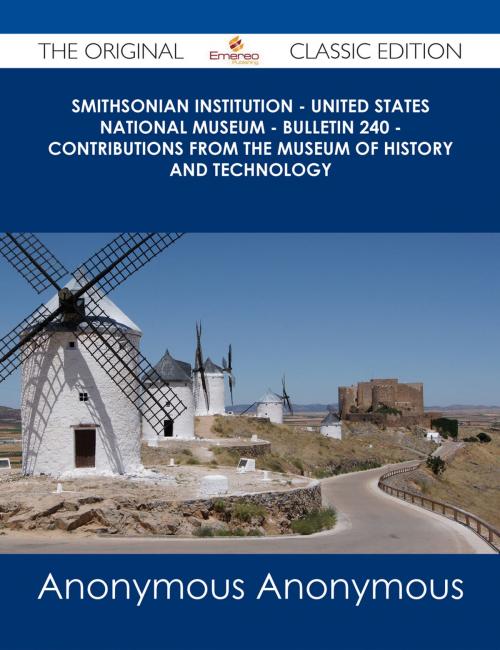Smithsonian Institution - United States National Museum - Bulletin 240 - Contributions From the Museum of History and Technology - The Original Classic Edition
Nonfiction, Reference & Language, Reference, Fiction & Literature| Author: | Anonymous | ISBN: | 9781486445165 |
| Publisher: | Emereo Publishing | Publication: | March 18, 2013 |
| Imprint: | Emereo Publishing | Language: | English |
| Author: | Anonymous |
| ISBN: | 9781486445165 |
| Publisher: | Emereo Publishing |
| Publication: | March 18, 2013 |
| Imprint: | Emereo Publishing |
| Language: | English |
Finally available, a high quality book of the original classic edition of Smithsonian Institution - United States National Museum - Bulletin 240 - Contributions From the Museum of History and Technology. It was previously published by other bona fide publishers, and is now, after many years, back in print.
This is a new and freshly published edition of this culturally important work by Anonymous Anonymous, which is now, at last, again available to you.
Get the PDF and EPUB NOW as well. Included in your purchase you have Smithsonian Institution - United States National Museum - Bulletin 240 - Contributions From the Museum of History and Technology in EPUB AND PDF format to read on any tablet, eReader, desktop, laptop or smartphone simultaneous - Get it NOW.
Enjoy this classic work today. These selected paragraphs distill the contents and give you a quick look inside Smithsonian Institution - United States National Museum - Bulletin 240 - Contributions From the Museum of History and Technology:
Look inside the book:
Fired by the hot-tube ignition system, the force of the explosion would drive both pistons down, forcing the outer one tight against the head of the smaller one, and at the end of the stroke the longer wall of the outer piston would strike an arm projecting into the cylinder near the open end, moving forward the exhaust valve rod to which the arm was attached, thus pushing open the valve in the head. ...No attempt was made at this time to use the electrical make-and-break circuit used in their second engine, as the free piston would have wrecked the igniter parts on the exhaust stroke, and the push rod located on the end of the piston would have prevented the piston from closing the exhaust valve. ...This engine, still on the carriage in the Museum of History and Technology, is cased with a water jacket, and has bases on top to support the front and rear bearings of the starting crankshaft, and a base with port on the upper right side where the exhaust-valve housing was to be bolted.
Finally available, a high quality book of the original classic edition of Smithsonian Institution - United States National Museum - Bulletin 240 - Contributions From the Museum of History and Technology. It was previously published by other bona fide publishers, and is now, after many years, back in print.
This is a new and freshly published edition of this culturally important work by Anonymous Anonymous, which is now, at last, again available to you.
Get the PDF and EPUB NOW as well. Included in your purchase you have Smithsonian Institution - United States National Museum - Bulletin 240 - Contributions From the Museum of History and Technology in EPUB AND PDF format to read on any tablet, eReader, desktop, laptop or smartphone simultaneous - Get it NOW.
Enjoy this classic work today. These selected paragraphs distill the contents and give you a quick look inside Smithsonian Institution - United States National Museum - Bulletin 240 - Contributions From the Museum of History and Technology:
Look inside the book:
Fired by the hot-tube ignition system, the force of the explosion would drive both pistons down, forcing the outer one tight against the head of the smaller one, and at the end of the stroke the longer wall of the outer piston would strike an arm projecting into the cylinder near the open end, moving forward the exhaust valve rod to which the arm was attached, thus pushing open the valve in the head. ...No attempt was made at this time to use the electrical make-and-break circuit used in their second engine, as the free piston would have wrecked the igniter parts on the exhaust stroke, and the push rod located on the end of the piston would have prevented the piston from closing the exhaust valve. ...This engine, still on the carriage in the Museum of History and Technology, is cased with a water jacket, and has bases on top to support the front and rear bearings of the starting crankshaft, and a base with port on the upper right side where the exhaust-valve housing was to be bolted.















